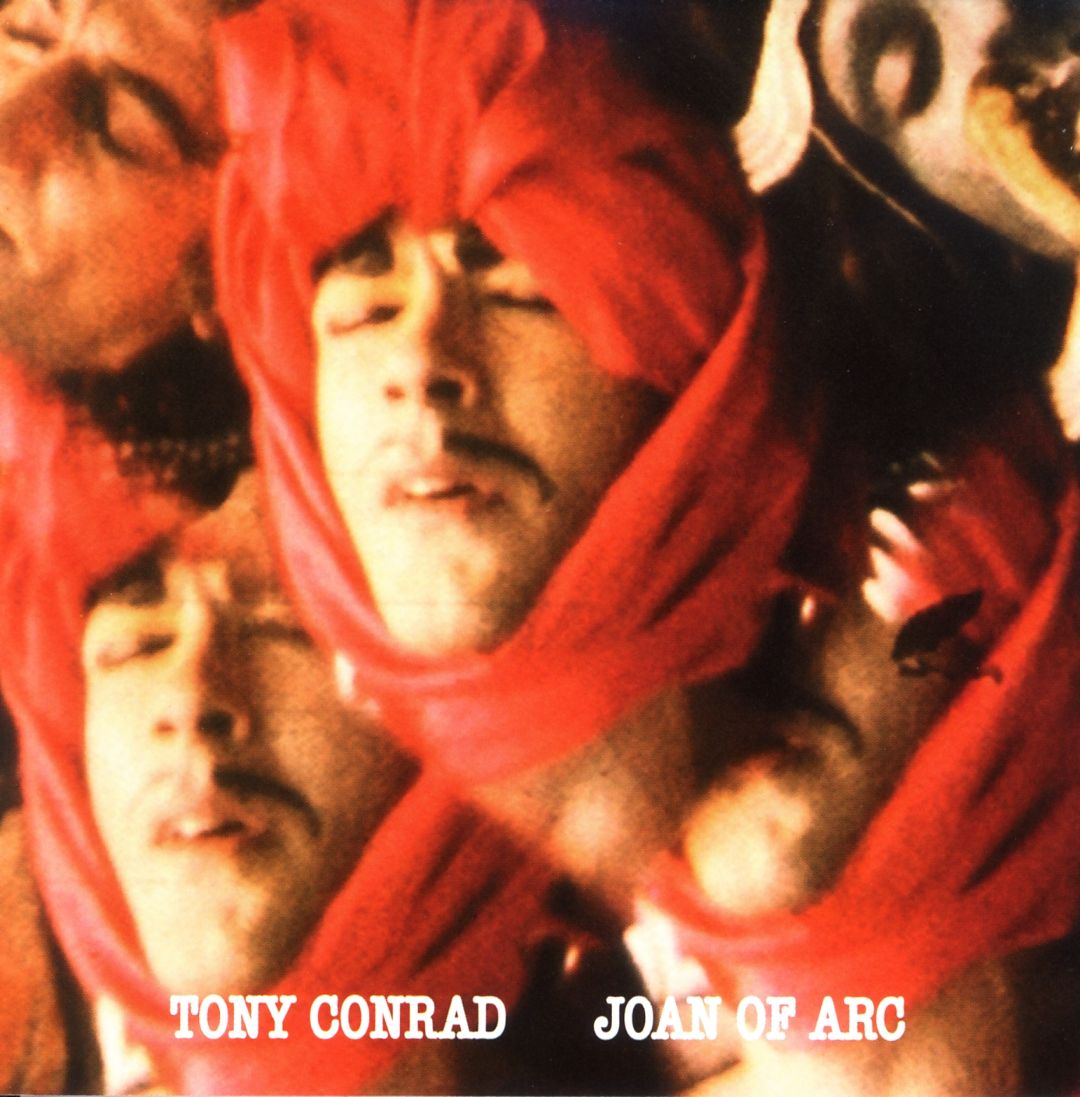“The man is just downright cool—about as cool as Hendrix, and almost always louder.”
Tony Conrad Collection no. 16)
Tony Conrad
Joan of Arc (1968)
2006
Table of the Elements
[Iridium] TOE-CD-77
Compact disc
Tony Conrad is a founding father of "minimalism" and a giant in the American soundscape. With help from Table of the Elements, Conrad's Audio ArtKive imprint continues to document the wild breadth of his 40-year career, with an array of releases that includes field recordings, piano compositions, power electronics and more.
The indefatigable Conrad kept busy during the Revolution Summer of 1968. In addition to his reunion recordings with John Cale (documented earlier this year in the Cale set "New York in the 1960s"), Conrad starred in Ira Cohen's legendary film "The Invasion of Thunderbolt Pagoda" and made extensive solo recordings, including Joan of Arc, available here for the first time. One of Conrad's personal favorites, it's a long piece for pump organ, in which he conjures both searing white heat and malignant gothic dread. An excerpt was used as the soundtrack for the Piero Heliczer film of the same name, but Conrad feels a greater affinity with that year's Cohen film; accordingly, Cohen graciously provided restored stills from "Thunderbolt Pagoda" for the packaging of this release. Cohen's sumptuous imagery—which Jimi Hendrix described as "looking through butterfly wings"—features a blissed-out and shirtless Conrad replete in pencil mustache, mascara and blood-red turban. The man is just downright cool—about as cool as Hendrix, and almost always louder.
“To anyone familiar with Tony Conrad's best-known works, Outside the Dream Syndicate and Four Violins (1964), mention of his name conjures a vivid sound: The drone of a bow slowly sawing across violin strings. Not that his other achievements—vital roles in the early minimalism of the Dream Syndicate, the early incarnations of the Velvet Underground, and the early experiments of American cinema—aren't equally memorable. But it's hard to picture him without a violin in his hands.
“Recent archival releases on Table of the Elements are changing that perception, offering examples of Conrad's work with sine-wave oscillation (Fantastic Glissando) and audio vérité (Bryant Park Moratorium Rally). Joan of Arc is the most exciting recovery yet, a solo pump-organ improvisation created to accompany Piero Heliczer's film of the same name. Conrad recorded the piece in 1968 at the home of John Vaccaro, director of New York's notorious Playhouse of the Ridiculous. Not knowing how much music Heliczer would need, Conrad played Vaccaro's aging instrument for the entire length of a one-hour reel-to-reel tape. (Heliczer ultimately used an excerpt for his 11-minute film.)
“As a display of energy and focus over an hour of unscripted time, Joan of Arc is simply impressive. Even more striking is how recognizable the piece turns out to be. On the surface, the pump-organ's low, moaning timbres, blurred by Conrad's lo-fi recording, share little with his violin's attacking treble. Rather than aggressive or sharp, his tone here is plaintive and often hymn-like. But the distinctive way he builds a drone, patiently layering and shifting it like wind and gravity shaping ocean waves, is unmistakable.
“The result is an entrancing meditation that rivals the work of latter-day masters Charlemagne Palestine and Phill Niblock, as well as the post-rock ambience of Stars of the Lid and Flying Saucer Attack and the metal dirges of Sunn0))) and Earth. What sets Joan of Arc apart is its all-alone aura. Drones often engulf their surroundings like a blinding snowstorm, but instead of evoking cold, dark landscapes, Joan of Arc feels warmly intimate, like crackling wood in a fireplace.
“Among all the sounds one might expect here—church-organ hums, cinematic chords, woozy groans—lies a surprise: an odd kind of percussion. Conrad's mic registers his foot tapping on pedals and his fingers clicking keys, creating rhythmic sparks and ripples beneath his cycling drone. As the organ swells and shrinks, these tactile sounds keep the piece grounded. Conrad's long chords may blow your mind, but his tangible effort makes Joan of Arc a dream come to life.”
Marc Masters, Pitchfork
“All right! New Tony Conrad! It's a good year. And there's (supposed to be, at least) a new Pandit Pran Nath disc on its way to my homestead as I type this! So despite what may be La Monte Young's best efforts, some of this music is making its way to the people. Just kidding La Monte (I can't afford a lawsuit). Of course this new Tony Conrad isn't really NEW new Tony Conrad, it's just never-before-heard Tony Conrad which is just as good (better?) as far as I'm concerned. "Joan of Arc" was recorded in 1968 as the soundtrack to a Piero Helicer movie of the same name which seems to be permanently AWOL, at least to the best of my knowledge.. It's a solo pump organ improvisation lasting 64 sweet minutes and is accompanied - as you can see on the cover - by stills from Ira Cohean's '68 film Invasion of the Thunderbolt Pagoda, which I also hope makes it to my doorstep someday
“It's difficult to come up with very many things to say about such a single-minded release, so I'll try and keep it short without being too verbose. There are a few things which jump to my mind at least a quarter of the way into "Joan of Arc", the first of which is the juxtaposition Conrad creates (however intentional) between the searing white pitch of the instrument and the brooding darkened tones which eventually take over almost completely. It's like listening to moonlight, if you can dig that. Like curling up on the grass in a field and letting luminous beams flood into your ear. But just as their is a juxtaposition with the result of the keys Conrad plays, there's also one audible in the grander scheme of the recording - not only can you heard the organ's final output but you can also hear the sounds it takes together. For example, Conrad's foot on the pump organ pedal often evoke a rhythmic spirit in the organ's drones that you didn't know were there until you heard the methods used to conjure them up. And then it all locked into place in your head until the foot-tapping went inaudible again and you were left to find your way once more.
“The composer's fingers also play the role of spectral tour guide, dancing around and sounding a bit like small rocks dropped into vast oceans, but they don't stay for long either. Of these external factors, however, the biggest compliment to "Joan of Arc"'s sound is the lo-fi tape recording it was committed too...it doesn't sound at all cleaned up and that's the way it should be. Apparently Conrad considers "Joan of Arc" one of his favorite pieces and I can understand why he'd be hesitant to alter it at all, even in the slightest way. I don't know if I prefer "Joan of Arc" to the violin works I've heard from Conrad...it's certainly a bit less...high strung? No pun intended, it just comes off a lot more mellowed, but of course that's the nature of the chosen instrument. If you like Charlemagne Palestine's organ drones, you should know where you're heading with this one and you know you're going to love it just like I did. Plus, the Con-man's stuff isn't always readily available at bargain-bin prices, but this one is as cheap as any other respectable CD you'll find and well worth the investment. Here's hoping Conrad's Audio ArtKive imprint provides many many more goods in the near future.
“It's so easy to call any kind of drone music boring, just out of reflex if for nothing else. But when you truly listen to a record like "Joan of Arc", the opposite becomes true - it provides an hour's worth of entirely stimulating, intriguing, organic music. And if you can't hear that, well I just plain feel sorry for you. Put it on your stereo, turn it up loud, and never fall asleep.”
Outer Space Gamelan




